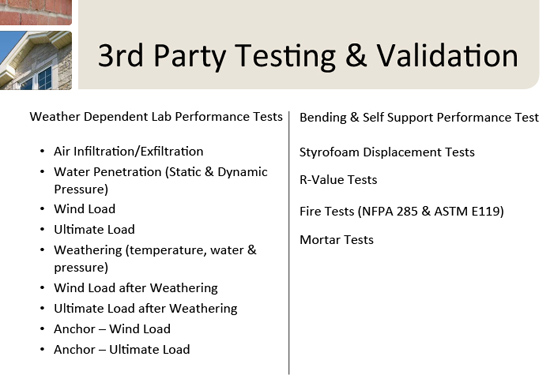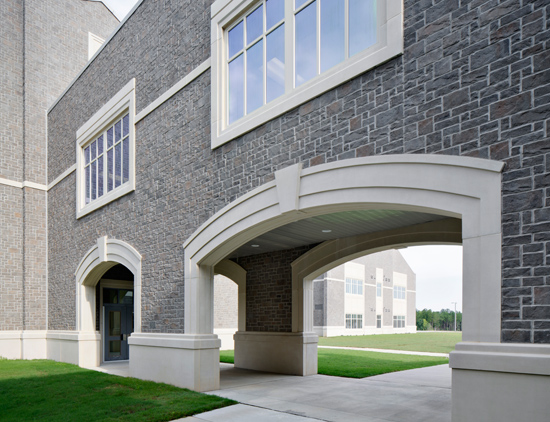Masonry Meets New Energy Codes
The foam is the key to the efficacy of the unit, adding good water management with drainage on both sides to take away any water that may infiltrate the wall and protect the structure from damage over its service life of high moisture exposure. R-values are high as well—9.1 Steady State and 13.6 including Thermal Mass. An STC of 51 and an NCMA TEK 13-1B sound transmission rating for concrete masonry walls means loud sounds are only faintly heard and occupants can enjoy their space in peace and quiet. Some foam systems have been proven to resist wind speeds of more than 110 mph according to ASTM E330 with no lasting deformation, which essentially eliminates the structural risk of damage experienced with lighter-weight veneers. Fire resistance criteria notably NFPA 285 and ASTM E119 assures that tested foam walls have successfully withstood one hour of exposure to temperatures of more than 1,700 degrees F. Foam panels systems should meet the above mentioned criteria as well as those in the accompanying table.
 |
To install the panels, foam is applied over sheathing, flashing, and one to two layers of a weather-resistant barrier. Stainless steel anchors are used for wood, steel, or concrete structures. Screws are used for wood studs, self-tapping screws for metal studs, and tapcons for concrete or CMUs. Protrusions along the top of the panel help stones to fit snugly into the foam. Concrete brick generally comes in 4-inch by 5-inch lengths, with +/- 3.25 bricks per square foot. Some manufacturers enable installation via an easy “paint by numbers” template. Mortar is then applied via an injection gun.
Architects should be aware that manufacturers are constantly coming out with new masonry units and improved features for the foam wall panels. New options include larger stone units; stacked stone; thin brick applications in 4 x 8 x 16; larger units up to 12 by 24 inches; larger foam panels up to 4 by 4; and redesigned anchors.
 |
A foam panel system satisfied multiple design goals with a single product for a South Carolina high school. Photo courtesy of Oldcastle® Architectural |
In practice, foam panel systems are achieving impressive results. The design team of the Westwood High School, Blythewood, South Carolina, chose the foam system for its ability to satisfy multiple design goals with a single product. Able to clad interior columns in addition to the exterior walls, the stone selected was a custom color blend offered the look and durability of natural stone for a fraction of the cost plus a number of sustainable design benefits. With an R-13.61 insulation factor, drainage channels that prevent moisture accumulation, and the ability to manufacture the product regionally with a percentage of recycled concrete, the system opened the door to a number of LEED® credit opportunities. “The placement grid provided by the insulation panels increased overall construction speed and virtually eliminated the 'oops' factor. The installation is even faster and cleaner than expected,” says Christopher M. Caudle, lead project architect, AAG Associates, LLC, in Beaufort, South Carolina.
In Beaver Dam, Wisconsin, a foam system was used for an apartment complex rehabilitation that required both aesthetic improvements and enhanced energy efficiency. The level of energy efficiency achieved qualified the project for funding from the U.S. Housing and Urban Development (HUD) Green Retrofit Program. The manufacturer trained the contractor and masonry crews on product installation and built on-site life-sized color samples for product selection. “The mason contractor loved the product because of the simplicity,” says project owner Col. Peter Knaup. After installation, engineers working for Wisconsin's Focus on Energy program discovered that a 20 percent reduction in air infiltration had occurred compared to previous measurements. “The engineers who did the testing could not believe the test numbers,” says Knaup. “They had never seen anything like it.”
The foam panel system also worked for the ReVISION House Orlando 2011. Before renovations, the ReVISION House was a typical Florida concrete block-style home. While originally built with a highly durable wall system able to withstand termites and hurricanes, it lacked quality insulation. Prior to renovation, the R2.5 walls were a major contributor to both heating and cooling loads. The “before” walls led to loads of 6.8 MBTU to heating and 14 MBTU to cooling on an annual basis. After renovating, annual loads dropped to 1.9 MBTUH for heating, and 2.5 MBTUH for cooling: a reduction of nearly 80 percent. These dramatic reductions not only save energy directly, but also improve occupant comfort and allow for a much smaller HVAC system, providing additional savings.
Foam Panel Systems Are a Sustainable Solution
Experts agree that R-value and continuous insulation requirements are here to stay—and they are only going to get stricter with each version of the IECC. Manufacturers have and will continue to respond to this reality. While various types of insulated masonry units abound, foam panel systems deliver an all-in-one energy-efficient, aesthetic, water management solution. This is an effective tool to have in meeting the present and future versions of the IECC, in meeting green goals, and in creating a sustainable built environment.
| No matter where you are, chances are Oldcastle® Masonry is there. You’ve probably seen Oldcastle® Masonry before in the places you most enjoy. Oldcastle® Architectural manufactures the products used in the interiors and exteriors of buildings across the nation. Join the satisfied customers who have chosen North America’s largest manufacturer of building products, Oldcastle® Architectural—the face of masonry. For more information, visit www.oldcastleapg.com |









